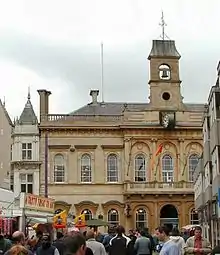Loughborough Town Hall
The Loughborough Town Hall is a building fronting onto the Market Place in Loughborough, Leicestershire, England. Built as a corn exchange and ballroom in 1855, it became a municipal building and subsequently a theatre. It is a Grade II listed building.[1]
| Loughborough Town Hall | |
|---|---|
 Loughborough Town Hall | |
| Location | Market Place, Loughborough |
| Coordinates | 52.77086°N 1.20638°W |
| Built | 1855 |
| Architect | William Slater |
| Architectural style(s) | Italianate style |
Listed Building – Grade II | |
| Designated | 5 November 1984 |
| Reference no. | 1361164 |
 Shown in Leicestershire | |
History
The origins of the building lie in the early 19th century, when four Loughborough tradesmen began a movement to provide the town with a public gathering place. It received much more momentum with the involvement of the local MP, Charles Packe of Prestwold Hall, who donated £500 towards the enterprise.[2] With his backing, other local gentry got on board, and £8,000 was raised for the purchase of land and the construction of the building. The Italianate style design, with decorative bellcote was the work of Northampton-born architect William Slater.[3] Charles Packe laid a ceremonial foundation stone in October 1854, and the building was completed in 1855.[2][4] The clock, which hangs from the main frontage of the building, was designed in 1879 and installed in 1880.[5] The bell, which was cast by John Taylor & Co, based in Loughborough was also installed at that time.[6]
The primary uses in its earliest days were as a ground floor corn exchange hall, where local farmers could meet and trade. Upstairs was a ballroom for the use of the gentry. However, from the outset all manor of public gatherings and entertainments were able to make use of the premises. Until 1888 Loughborough had no town charter and was administered by the lord of the manor, and more latterly by local boards with specific responsibility for water and sanitation works, highways, schools, and burials.[2] When Loughborough received a charter in 1888, the new council took on these roles for the town, and was in need of a suitably dignified administrative base. The Corn Exchange company agreed to sell the building and, after it had been converted into a town hall, it re-opened as a municipal building in 1890.[3]
The suffragette, Emmeline Pankhurst, spoke at Loughborough Town Hall during the 1910 General Election.[7]
The building was damaged during a serious fire in 1972.[8] It was the headquarters of the Municipal Borough of Loughborough but it ceased to be the local seat of government when the Borough of Charnwood was formed in 1974.[9] The building was converted into a theatre to the designs of Goodwin, Warner and Associates between 1973 and 1974.[3] An extensive refurbishment of the building, which was undertaken by G. F. Tomlinson at a cost of £5 million, was completed in November 2004.[10][11]
References
- Historic England. "Town Hall, Market Place (1361164)". National Heritage List for England. Retrieved 10 April 2020.
- "Mayoralty in Charnwood, 2016". charnwood.gov.uk. Charnwood Borough Council. 2016. p. 16.
- Pevsner, Nikolaus; Williamson, Elizabeth (1985). The Buildings of England: Leicestershire and Rutland. Pevsner Architectural Guides. p. 291. ISBN 978-0140710182.
- Lambert, Tim. "A Brief History of Loughborough, Leicestershire, England". localhistories.org. Retrieved 7 January 2014.
- "Ding Dong the clock is back". Loughborough Community Eye. 1 February 2018. Retrieved 10 April 2020.
- "Loughborough Town Hall bell to ring again". Loughborough Echo. 9 February 2018. Retrieved 1 August 2020.
- "Tales of Suffragettes and unruly crowds in Loughborough". Loughborough Echo. 4 March 2016. Retrieved 1 August 2020.
- "The story of Loughborough's brave fire fighting force". Loughborough Echo. 1 June 2014. Retrieved 10 April 2020.
- Local Government Act 1972. 1972 c.70. The Stationery Office Ltd. 1997. ISBN 0-10-547072-4.
- "Performance and Audit Scrutiny Committee" (PDF). Borough of Charnwood. 11 July 2006. Retrieved 1 August 2020.
- "Loughborough Town Hall". G. F. Tomlinson. Retrieved 1 August 2020.